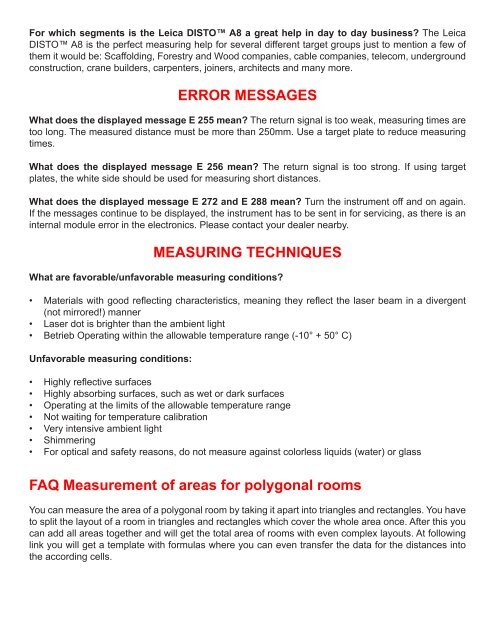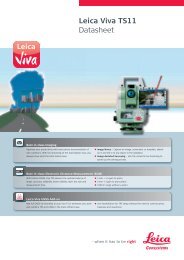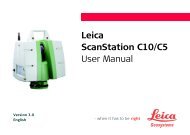LEICA DISTO FAQ
LEICA DISTO FAQ
LEICA DISTO FAQ
You also want an ePaper? Increase the reach of your titles
YUMPU automatically turns print PDFs into web optimized ePapers that Google loves.
For which segments is the Leica <strong>DISTO</strong> A8 a great help in day to day business? The Leica<br />
<strong>DISTO</strong> A8 is the perfect measuring help for several different target groups just to mention a few of<br />
them it would be: Scaffolding, Forestry and Wood companies, cable companies, telecom, underground<br />
construction, crane builders, carpenters, joiners, architects and many more.<br />
ERROR MESSAGES<br />
What does the displayed message E 255 mean? The return signal is too weak, measuring times are<br />
too long. The measured distance must be more than 250mm. Use a target plate to reduce measuring<br />
times.<br />
What does the displayed message E 256 mean? The return signal is too strong. If using target<br />
plates, the white side should be used for measuring short distances.<br />
What does the displayed message E 272 and E 288 mean? Turn the instrument off and on again.<br />
If the messages continue to be displayed, the instrument has to be sent in for servicing, as there is an<br />
internal module error in the electronics. Please contact your dealer nearby.<br />
MEASuRInG TECHnIQuES<br />
What are favorable/unfavorable measuring conditions?<br />
•<br />
•<br />
•<br />
Materials with good reflecting characteristics, meaning they reflect the laser beam in a divergent<br />
(not mirrored!) manner<br />
Laser dot is brighter than the ambient light<br />
Betrieb Operating within the allowable temperature range (-10° + 50° C)<br />
unfavorable measuring conditions:<br />
•<br />
•<br />
•<br />
•<br />
•<br />
•<br />
•<br />
Highly reflective surfaces<br />
Highly absorbing surfaces, such as wet or dark surfaces<br />
Operating at the limits of the allowable temperature range<br />
Not waiting for temperature calibration<br />
Very intensive ambient light<br />
Shimmering<br />
For optical and safety reasons, do not measure against colorless liquids (water) or glass<br />
<strong>FAQ</strong> Measurement of areas for polygonal rooms<br />
You can measure the area of a polygonal room by taking it apart into triangles and rectangles. You have<br />
to split the layout of a room in triangles and rectangles which cover the whole area once. After this you<br />
can add all areas together and will get the total area of rooms with even complex layouts. At following<br />
link you will get a template with formulas where you can even transfer the data for the distances into<br />
the according cells.<br />
<strong>DISTO</strong>S <strong>FAQ</strong>.indd 18 30/06/2011 12:50:29 PM





